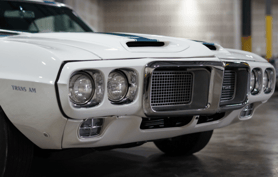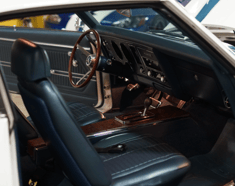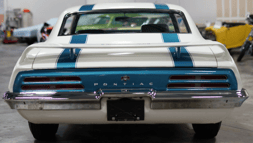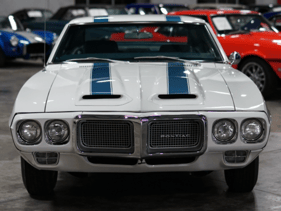
Kimberly V. Althage – March 11, 2022
Gateway Classic Cars of Fort Lauderdale is proud to present this handsome 1969 Pontiac Firebird Trans Am. The ‘Pony Car’ became the name for a new class of vehicles after the launch of the 1964 Ford Mustang. The end of the decade the championship known as the Trans Am challenge became popular with both the crowds and manufacturers alike. Pontiac was a little late to the party in the pony car wars. It did not make its public debut until the 1969 Chicago Auto Show. Although development of the Trans Am concept dates back to a 1967-’68 engineering project known internally as Pontiac Firebird Sprint Turismo (PFST), its introduction was under the radar and had little fanfare.
The PFST was influenced by John DeLorean’s affinity for European sports cars. If he had his way in the late 1960s, there might not have been a Trans Am. DeLorean was more interested promoting and building his radical Banshee XP-833 concept car. He was crushed when the bigwigs at GM axed the project believing the Banshee was too much like the Corvette. Afterward, DeLorean dedicated his energies to making Firebird and Trans Am better than the Camaro. He wanted to distinguish the Pontiac brand as being superior to Chevrolet in all respects and his partnership with Herb Adams lead to the birth of the legendary Trans Am.
This “consolation prize” caused a little controversy initially. The “Firebird” name was used on previous 1950s and early 1960s GM concept cars. “Trans Am” was a specialty package available for the Pontiac Firebird, yet despite its name it could not be homologated for Trans-Am racing series due to its engine size. More importantly Pontiac used “Trans Am” without SCCA’s permission, who threatened suit. GM settled the dispute by paying $5 licensing fee to the SCCA for each Trans Am sold.
Despite naming the car after a popular SCCA race series, as already mentioned its introduction was under the radar and few people knew of its existence. In fact, it is nearly impossible to find any literature since it received little to no advertising. Initially offered as a limited-production special with several key pieces of top-shelf equipment, a mere 697 of these vehicles rolled off the assembly line for the 1969 model year. Due to low production numbers, the 1969 Firebird Trans Am is relatively rare and became an instant collectible.
To celebrate the Firebird’s entry in the Trans Am championship, a special commemorative version was constructed. Therefore all 1969 Trans Ams have the color scheme of Cameo Ivory trimmed with Tyrol Blue dual stripes and tail panel. Their colors are a direct tribute to Sport Car Club of America racing and made them easy to spot.
Beyond cosmetic color, the 1969 model received a major facelift, even though a full restyle was coming the following year. The 1969 Trans Am had the 1969 Firebird’s attractive body styling. It was more muscular in appearance than the previous two model years giving it an aggressive look. The most striking change was up front, with its bumpers integrated into the design and the headlights being separated from the grille. This gave it a more streamlined look and helped distinguish the Firebird from the similar looking Camaro.

Other changes stood out and were equally easy to spot. The highly modified hood was unique to the model and had functional air inlets to aid engine breathing. The working air scoops could be opened or closed by the driver from the cockpit. It was an integral part of the Ram Air system, while front and rear spoilers kept the F-body glued to the pavement. The distinctive full-width rear foil (spoiler) mounted on the trunk proved to add downforce at higher speeds. The Firebird’s rear “slit” taillights were inspired by the 1966–1967 Pontiac GTO. All these redesigns and lack of color options were not well received by customers. Sales fell despite production lasting 17 months due to production problems with the 1970 model.
The standard engine was the 400 cubic-inch L74, also dubbed the “Ram Air III,” it was a name never used by Pontiac. The Ram Air III V-8 had a high-performance Quadrajet 4-barrel carburetor, a dual exhaust system, and high-performance D-port heads. The RA III also received a slightly hotter camshaft, a functional ram air induction system, and cast-iron exhaust manifolds redesigned to improve breathing. Like other Pontiac V8 engines of the era the RA III was painted in Pontiac Light Blue Metallic.

Pontiac’s Ram Air engines quickly became the stuff of legend, even though they were highly underrated. The RA III stated 335 horsepower, when its actual horsepower output approached 400 gross horsepower territory. Pontiac gave the Firebird’s best high-performance engines to the Trans Am, and the 1969-1970 Ram Air III 400 was one of Pontiac’s highest-performance V8s.
Although its original reception was lacking, the 1969 Pontiac Firebird Trans Am is a potent performer, and in many ways the performance icon of the pony car market. It is one of the best-known American muscle cars, and it ultimately dethroned the mighty GTO as Pontiac’s most popular performance model. Today the 1969 Trans Am is highly sought after.
If you would like to learn more about this 1969 Pontiac Firebird Trans Am, please contact our team in the Fort Lauderdale Showroom.
Gateway Classic Cars sells and consigns hundreds of vehicles each month. Do you have a classic car for sale with a story to tell? We’d love to hear about it, please email us at news@gatewayclassiccars.com to share it.



Comments